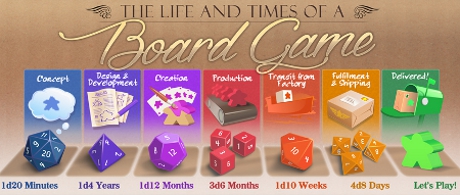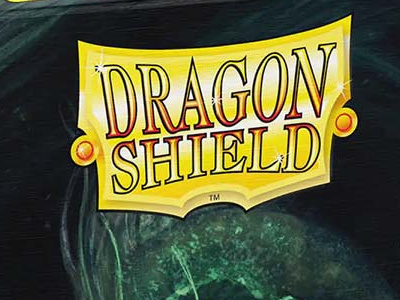 The Life and Times of a Board Game is a new tabletop game industry series written by Dan Yarrington, founder and CEO of Game Salute. Yarrington has nearly 20 years professional experience in the game industry, having founded the Myriad Games retail store in 1996.
The Life and Times of a Board Game is a new tabletop game industry series written by Dan Yarrington, founder and CEO of Game Salute. Yarrington has nearly 20 years professional experience in the game industry, having founded the Myriad Games retail store in 1996.Welcome to The Life and Times of a Board Game, a new series about all the incredible things that happen in the tabletop game industry. This week, I’ll provide a brief overview of the concept of The Life and Times of a Board Game, share my vision for the series, and invite you to join in with your ideas and experiences.
The Life and Times of a Board Game is intended as a series of stories, akin to This American Life or Planet Money. There are a ton of amazing stories and experiences that folks all around the industry have every day. This series is designed to share those stories and in doing so explore the various stages of how games are conceived, designed, developed, created, printed, shipped, sold, and every other element of the life of a board game.
The idea for this series was in response to folks reviewing The Life and Times of a Board Game page that we created to help customers understand the life cycle and production process for new games. We’ve gotten overwhelmingly positive feedback on the insights provided on podcasts, at presentations in person, and through day to day operations within the industry. The excellent graphics that help convey the stages of the life cycle were created by in the inestimable Dann May.
This series is designed to expand on those concepts, bring in your experiences and answer your questions. It’s designed to bring you meaningful stories that will affect how you view the tabletop games industry and our place in the overall economy, culture, and the world at large.
For this introduction, I’ll walk through the graphic shown here and the corresponding stages of The Life and Times of a Board Game. You’ll note that each stage has a different die roll associated with it to help convey the amount of time that stage takes. These are not firm, precise numbers and that’s intentional due to the wide variability inherent in the often chaotic process of creating tabletop games and bringing them to market. Sometimes you get lucky and production takes three months, sometimes it stretches on for over a year. Sometimes transit from the factory happens in a week or two and sometimes your shipping container gets flagged by customs and delayed for two months or more. And sometimes you just have to re-roll a step.
Concept (1d4 Minutes)
It all begins with an idea. This is the easiest of the steps. 1% inspiration, 99% perspiration and all that jazz. This is usually free association of "What if we made a deck builder that also __________?" or "What if we made a game that took this game and took out _________ which totally ruins the game?" or "What if we mashed these two games together?" Easy, fun, and dangerous. Too many ideas and that leads into the more meticulous part...
Design and Development (1d4 Years)
So many people confuse "Concept" with "Design." I can’t count the number of times I’ve seen a submission (and we’ve received over 1,048 in the past two and a half years) that said "This design is awesome and ready to publish" and when we asked for the rules, they didn’t have any ready. Or they’d playtested the game 12 times in total. Or only with the same three people who absolutely, totally love it and agree with them that it’s the greatest game ever and come on why haven’t you signed this game yet?!? Development takes time and patience and diligence, and those are all too often in short supply.
Creation (1d12 Months)
Creation sounds fun - creating all the art descriptions and the actual art, coming up with flavor text, doing the graphic design, deciding on components and form factors and converting your ugly prototype into a thing of beauty and a joy forever. And it can be fun, especially when working with the right team. You can also run into a ton of delays due to artists who blow through deadlines, designers updating mechanics and stats halfway through creation requiring an entire overhaul of layouts, frustration with the quality level you’re achieving vs. what you envisioned, and a variety of other impediments to completing the creative process.
Production (3d6 Months)
Production is typically handled by one main factory or printer who works with subcontracted factories to provide specialized pieces like wooden bits or dice or plastics. Then they print the rules, cards, boxes, inserts, and punchboards and assemble everything. This process takes a while because board games are inherently complex products, especially when you have a variety of supply chains involved for varied components. Then you have proofing and samples and reworking graphic files and more proofing. Then finally safety testing and packing to prepare for...
Transit from Factory (1d10 Weeks)
We’ve had truckload shipments come overnight from domestic factories, but more often it is 4-6 weeks by sea freight in a gigantic shipping container to help keep costs down. And then you hope that the container doesn’t have a leak in it and 102 damaged cartons of games. This is a frustrating period because you don’t seem to be doing anything other than waiting.
Fulfillment and Shipping (4d8 Days)
This is the step that trips most folks up because it seems simple at the outset (put boxes in other boxes and ship them). In reality you’re dealing with receiving, inventory counts, damaged product, sorting, assembling kits of products with promo cards, coordinating with the sales team, reserving product for conventions or other special events, address updates, supplies purchasing, recounting, packing, labeling, customs paperwork, and finally shipping and follow through.
Delivered!
Finally, at long last, after months or years or trials and tribulations, your game is finally delivered to individuals and/or stores where it will find a good home. People can play it and share it with their friends, and let everyone else know how awesome it is…or more likely play it once say “It was alright” and move on to the next game. These are the harsh Dickensian realities of the board game industry.
What About The Rest?
But what about Sales, you say? Or Marketing? Or Conventions? Or Customer Service? Or how to best liquidate product once it’s been sitting in your warehouse for years unmoving? Worry not, stalwart reader, we’ll get into all of that part of our exploration of The Life and Times of a Board Game.
I invite each and every one of you to participate in this by writing in comments through the site, emailing me at Dan@GameSalute.com, following and tweeting @GameSalute, or messaging me on Facebook. I’m looking forward to bringing your stories to life, so don’t hesitate to send in your suggestions and requests. We’ll have interviews, articles, and just plain ol’ tall tales from the desks of game creators, from the tables of regular gamers, from the halls of friendly local game stores, and from all areas of the industry.
--Dan Yarrington is founder and CEO of Game Salute and the founder of Myriad Games. He is an enthusiastic husband, father, brother, son, and avid and perpetual game evangelist in all these roles.
The opinions expressed in this column are solely those of the writer, and do not necessarily reflect the views of the editorial staff of ICv2.com.








